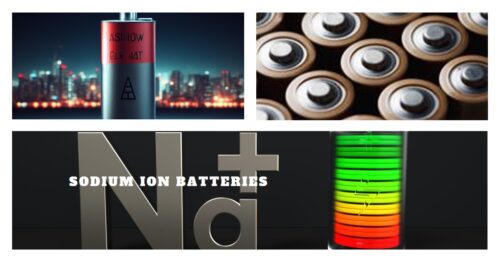Sodium Ion Battery : Will it Power the Future
Forget lithium, say hello to sodium. In the ever-evolving world of energy storage, a new player is rising through the ranks – the sodium ion battery. No longer relegated to dusty research labs, these eco-friendly powerhouses are poised to revolutionize everything from your phone to your electric vehicle. Buckle up, because we’re about to dive headfirst into the exciting world of NIBs (Na+ Sodium Ion Battery) and explore why they might just be the future of batteries.
Breaking Free from Lithium’s Grip
For decades, lithium-ion batteries have reigned supreme, powering our gadgets and electrifying our transportation. But this reign isn’t without its thorns. Lithium, the kingpin of the battery world, is unevenly distributed, environmentally costly, and prone to price fluctuations. Enter sodium, lithium’s abundant and affordable cousin. Imagine a battery packed with the punch of lithium but sourced from the world’s oceans – that’s the Sodium ion battery dream.
But here’s the catch: sodium ions, bless their hearts, are a tad bigger and clumsier than their lithium counterparts. This means they move around slower, translating to slightly lower energy densities in NIBs compared to LIBs. Think of it like trying to squeeze a watermelon through a keyhole – it’s just not as efficient.
However, what NIBs lack in pure energy, they more than make up for in other areas. They’re significantly cheaper to produce, thanks to sodium’s widespread availability. Plus, they boast superior safety profiles, with a lower risk of fiery meltdowns that can plague lithium batteries. And let’s not forget the environmental bonus – Sodium Ion Battery is inherently greener, with less mining and processing involved.
From Lab Rats to Road Warriors: The NIB Revolution is Here
The journey of NIBs hasn’t been without its bumps. For years, they languished in labs, overshadowed by their flashier lithium cousins. But the tide is turning. Major players like CATL, the world’s battery behemoth, have jumped on the sodium bandwagon, ramping up production and pushing NIBs closer to commercialization.
This isn’t just hype – we’re already seeing tangible progress. In China, NIB-powered electric test cars are taking to the streets, proving their real-world capabilities. Energy storage giants like Pylontech are paving the way for widespread adoption with their NIB certifications. The future is looking bright, folks!
So, NIBs or LIBs? The Verdict is In… (Sort of)

Choosing between NIBs and LIBs isn’t a simple binary decision. It’s a dance between needs and priorities. If raw power and every last watt of energy density are your top concerns, then LIBs might still be your go-to. But if you value affordability, safety, and environmental sustainability, then NIBs are knocking on your door.
Think of it this way: LIBs are the sleek sports cars of the battery world, while NIBs are the trusty SUVs. They might not be the fastest on the track, but they’ll get you where you need to go reliably and without breaking the bank (or the planet).
The NIB revolution is just beginning, and its potential is electrifying. With continued research and development, these sodium-powered marvels could reshape the battery landscape, powering a cleaner and more sustainable future. So, the next time you reach for your phone or hop into your electric car, remember – the age of sodium might just be dawning.
HISTORY
Sodium Ion Battery development took place in the 1970s and early 1980s. However, by the 1990s, lithium-ion batteries had demonstrated more commercial promise, causing interest in sodium-ion batteries to decline. In the early 2010s, sodium-ion batteries experienced a resurgence, driven largely by the increasing cost of lithium-ion battery raw materials.
OPERATING PRINCIPLE
Sodium Ion Battery cells consist of a cathode based on a sodium-based material, an anode (not necessarily a sodium-based material) and a liquid electrolyte containing dissociated sodium salts in polar protic or aprotic solvents. During charging, sodium ions move from the cathode to the anode while electrons travel through the external circuit. During discharge, the reverse process occurs.
MATERIALS
Due to the physical and electrochemical properties of sodium, Sodium Ion Battery require different materials from those used for LIBs.
Anodes can be : Carbons, Graphene, Carbon arsenide, Metal alloys, Metals, Oxides, Molybdenum disulphide.
Cathodes can be : Oxides, Oxoanions, Prussian blue and analogues.
Electrolytes : Sodium-ion batteries can use aqueous and non-aqueous electrolytes. The limited electrochemical stability window of water results in lower voltages and limited energy densities. Non-aqueous carbonate ester polar aprotic solvents extend the voltage range. These include ethylene carbonate, dimethyl carbonate, diethyl carbonate, and propylene carbonate. The most widely used salts in non-aqueous electrolytes are NaClO4 and sodium hexafluorophosphate (NaPF6) dissolved in a mixture of these solvents. It is a well-established fact that these carbonate-based electrolytes are flammable, which pose safety concerns in large-scale applications. A type of glyme-based electrolyte, with sodium tetrafluoroborate as the salt is demonstrated to be non-flammable. Of course, electrolyte additives can be used as well to improve the performance metrics.
Safety Concerns: Tesla Factory Worker Attacked by a Robot Raises Alarms
